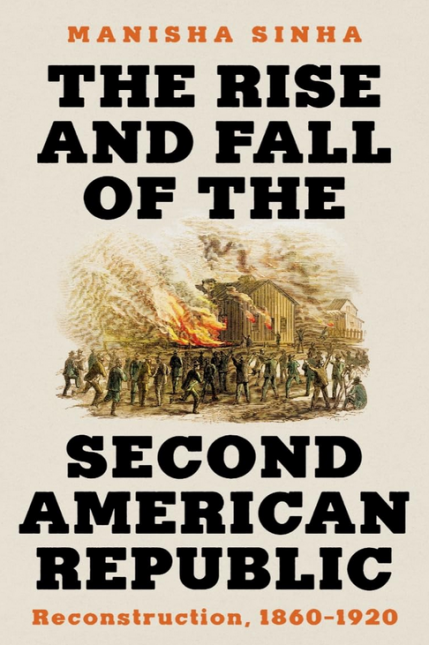The Rise and Fall of the Second American Republic: Reconstruction, 1860-1920
- By Manisha Sinha
- Liveright
- 592 pp.
- Reviewed by Eugene L. Meyer
- April 1, 2024
Our nation has a long record of just barely doing the right thing.

Eric Foner, the distinguished historian of the Civil War era, remarked in the preface to his own book on Reconstruction that the period “cannot be fully understood without attention to its distinctively Northern and national dimensions.” Now, Manisha Sinha, a Foner acolyte at Columbia University and the Draper Chair in American History at the University of Connecticut, has written a book focusing on just that.
The India-born historian and author of The Slave’s Cause: A History of Abolition has crafted a sweeping new history of what she terms the “Second American Republic.” She has widened the lens to take in six decades of struggle and defeat in the ongoing battle between progressive change and reactionary retrenchment. Though meant to be a history, the story she tells in The Rise and Fall of the Second American Republic is achingly relevant. And it is not one to inspire hope or optimism for the present or future.
Her Reconstruction “era” challenges traditional timelines that span only the immediate post-bellum period, from the military triumph of the Union Army and the enactment of civil-rights laws and amendments to the contested 1876 presidential election and the corrupt political bargain of 1877 that facilitated the election of a Republican president more in tune with the “restoration” of the antebellum order. This Faustian bargain removed most federal troops from the secessionist states and returned political power to unreconstructed rebels determined to turn back the clock on newly won Black rights. Jim Crow laws quickly followed.
In Sinha’s telling, Northern capitalists and Southern racists — “the lords of the loom and the lords of the lash” — joined forces to create “the New South” that resembled an economy more akin to slavery than to freedom. This unholy alliance became a vehicle for “Manifest Destiny” as the United States forcibly added states formerly part of Mexico, displaced Indigenous peoples, and engaged in offshore empire-building in the Pacific and Caribbean.
The battle for women’s suffrage, though tinged with racism as well, is seen as the last great chapter in Sinha’s Second American Republic and brings us to 1920 and the adoption of the 19th Amendment. However, notes the author, not all states approved the amendment. Some, in fact, had held out against even the emancipatory 13th Amendment well into the 20th century; Mississippi, the last to ratify it, didn’t do so until 1995.
The section of the book on Andrew Johnson, a Tennessee Unionist vice president who ascended to the presidency in 1865 upon the assassination of Abraham Lincoln, offers fresh insights into his impeachment by the House of Representatives and ultimate acquittal by the Senate. The outcome hinged on one pivotal “no” vote cast by Kansas Republican Edmund G. Ross. The proximate cause of Johnson’s impeachment was his dismissal of Secretary of War Edwin Stanton, a holdover from the Lincoln cabinet. But the case against Johnson rested more firmly on his repeated vetoing of measures designed to ensure the rights of the formerly enslaved.
Relying on Lincoln’s Second Inaugural pledge of “malice toward none, charity to all,” Johnson was committed to “restoration,” not Reconstruction. He was quick to pardon former insurrectionists, including the Confederacy’s president, Jefferson Davis. That resurgent whites were terrorizing Black citizens and their white Southern allies was of no concern.
Given Johnson’s favorable disposition toward the oppressors, the crucial vote cast by Senator Ross seems much less the “profile in courage” depicted in John F. Kennedy’s lauded Profiles in Courage. Bribery, writes Sinha, was also a motivating factor for Johnson.
Sinha doesn’t gloss over the imperfections and flaws of those who championed the cause of civil rights but made compromises (and even joined) with the more conservative Republican “liberals” to impede Black progress. She places the start of the Second American Republic in 1860, with Lincoln’s election, but at one point dates its demise to the dubious outcome of the 1876 election. Yet, more broadly, she sees the legacy of both hope and disappointment running well into the 20th century. She does not suggest a Third American Republic — encompassing FDR’s New Deal, postwar prosperity, and the civil-rights gains of the 1960s — but it’s fair to note that that “republic” also seems to have fallen, or is at least endangered.
Scattered throughout the book are references to current events that have engulfed and polarized the nation in much the same way as in the bygone era. She notes, for example, the long-ago cries of voter fraud claimed by whites to discredit Black-majority state legislatures that are echoed today by conservatives allegedly engaged in voter suppression. She underscores such parallels in her introduction:
“Today, the attempt by conservatives to unravel the New Deal state and civil rights laws — and the advent of a new Gilded Age — reveal that the great contest between democracy and capitalism, equality, and inequality, interracialism and racist authoritarianism, feminism and patriarchy, is far from over. Democracy itself, the history of Reconstruction reveals, can be systematically overthrown and repressed for long periods in US history. As then, so too today: democracy’s viability and future lie in the hands of ordinary citizens.”
Reconstruction continues “to shape the contours of our democracy, in ways little understood by most Americans today,” Sinha writes. Implicitly, she asks: Does the long arc of history truly bend toward justice? Or will the forces of darkness ultimately prevail? Based on her important and deeply researched book, these remain open and troubling questions.
Eugene L. Meyer, a member of the board of the Independent, is a journalist and author of, among other books, Hidden Maryland: In Search of America in Miniature and Five for Freedom: The African American Soldiers in John Brown’s Army. Meyer has been featured in the Biographers International Organization’s podcast series.

